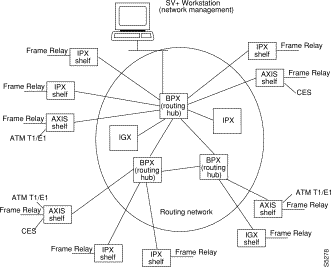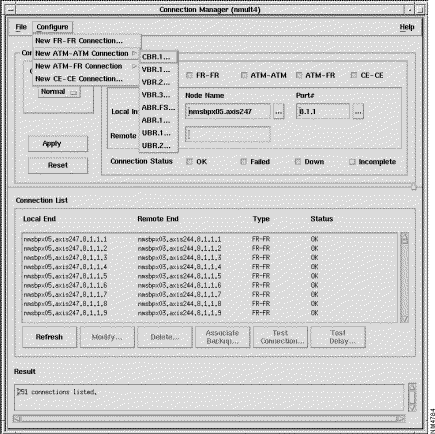|
|

This chapter describes the BPX tiered networks that provides the capability of adding interface shelves/feeders (non-routing nodes) to an IPX/IGX/BPX routing network. A tiered network with BPX Service Node hubs supports frame relay connections typically over IPX and AXIS feeders although an IGX could also be uses as a feeder.
Tiered networks with BPX routing hubs have the capability of adding interface shelves/feeders (non-routing nodes) to an IPX/IGX/BPX routing network (Figure 6-1). The AXIS shelf, and IPX or IGX nodes configured as shelves are connected to BPX nodes. Interface shelves allow the network to support additional connections without adding additional routing nodes.
The AXIS supports frame T1/E1, X.21 and HSSI frame relay, ATM T1/E1, and CES, and is designed to support additional interfaces in the future. The IPX interface shelf supports frame relay ports, as does the IGX (option is available to configure as a shelf).

The following requirements are necessary in order to implement tiered networks in Release 8.4:
Annex G, a bi-directional protocol, defined in Recommendation Q.2931, is used for monitoring the status of connections across a UNI interface. Tiered Networks use the Annex G protocol to pass connection status information between a Hub Node and attached Shelf.
AXIS Interface Shelf | A standards based service interface shelf that connects to a BPX, aggregrates and concentrates traffic, and performs ATM adapation for transport over broadband ATM networks. |
BPX Core Switch Shelf | Designation of a BPX Service node in a routing network |
BPX Interface Shelf | Designation for an IPX interface shelf or an AXIS interface shelf connected to a BPX Core Switch Shelf. |
Interface Shelf Trunk | Refers to a trunk which interconnects an interface shelf with the Routing Network (i.e., BPX). |
Hub Node | A node in the routing network which has attached shelves. The BPX Core Switch shelf is a hub node. |
IPX Interface Shelf | A special configuration of the IPX narrow band node designated as a BPX interface shelf. Sometimes referred to as IPX A/F. |
IPX/AF | Another name for the IPX interface shelf |
Routing Network | The portion of the IPX/IGX/BPX network which performs automatic routing between connection endpoints. |
VPI | Virtual Path Identifier |
VCI | Virtual Connection Identifier |
A tiered network requires the following:
Converting an IPX or IGX node to an Interface Shelf requires re-configuring connections on the node, as no upgrade path is provided in changing a routing node to an interface shelf.
Only BPX nodes are able to act as connection points (Hub Nodes) into Routing Network for Shelves. A BPX node, acting as a Hub Node, is not restricted from providing any other feature which is normally available on BPX nodes. A BPX Hub supports up to 16 Shelves.
Connections within Tiered Networks consist of distinct segments within each tier. A routing segment traverses the Routing Network, and a Shelf segment provides connectivity to the Shelf end-point. Each of these segments are added, configured and deleted independently of the other segments. The SV+ Connection manager provides management of these individual segments as a single end-to-end connection.
Shelves are attached to the Routing Network via a BPX node using a BXM trunk (T3/E3 or OC3) or BNI trunk (T3/E3). The connection segments within the Routing Network are terminated on the BNI shelf trunks.
All frame relay connection types which can terminate on the BPX ASI card are supported on the BNI shelf trunk (currently VBR, CBR, ABR, and ATF types). (For the initial 8.1 Release, the IPX and AXIS Interface Shelves support the ATF connection type. Additional connection types will be supported in future releases.). No check is made by the Routing Network to validate whether the connection segment type being added to a BNI shelf trunk is actually supported by the attached Shelf.
The trunk between a Shelf and the Routing Network is a single point of failure, therefore, the Shelves should be co-located with their associated Hub Node. Card level redundancy is supported by the Y-Cable redundancy for the BXM, BNI, and AIT.
Communication between the Routing Network and the Interface Shelves is provided in accordance with Annex G of Recommendation Q.2931. This is a bidirectional protocol for monitoring the status of connections across a UNI interface. (Note: the Interface Shelf Trunk uses the STI cell format to provide the ForeSight rate controlled congestion management feature.)
Communication includes the real time notification of the addition or deletion of a connection segment and the ability to pass the availability (active state) or unavailability (inactive state) of the connections crossing this interface.
A proprietary extension to the Annex G protocol is implemented which supports the exchange of node information between a Shelf and the Routing Network. This information is used to support the IP Relay feature and the Robust Update feature currently used by Network Management.
Network Management access to the Interface Shelves is through the IP Relay mechanism supported by the SNMP and TFTP projects or by direct attachment to the Shelf. The IP Relay mechanism is extended to relay traffic from the Routing Network to the attached Feeders. No IP Relay support is provided from the Shelves into the Routing Network.
The BPX as a Routing Hub is the source of the network clock for its associated feeder nodes. Feeders synchronize their time and date to match their routing hub.
Robust Object and Alarm Updates are sent to a Network Manager which has subscribed to Robust Updates feature. Object Updates are generated whenever a Shelf is added or removed from the Hub node and when the Shelf name or IP Address is modified on the Shelf. Alarm Updates are generated whenever the alarm state of the Shelf changes between Unreachable, Major, Minor and OK alarm states.
A Shelf is displayed as a unique icon in the SV+ Network Management topology displays. The colors of the icon and connecting trunks indicate the alarm state of each. Channel statistics are supported by FRP, ASI, and AXIS endpoints. BNIs and AITs do not support channel statistics. Trunk Statistics are supported for the shelf trunk and are identical to the existing BNI trunk statistics.
Foresight for IPX Shelf terminated Frame Relay connections is provided end-to-end between Frame Relay ports, regardless as to whether these ports reside on an IPX Shelf or within the Routing Network.
Preferred routing within the Routing Network can be used on all connections. Priority bumping is supported within the Routing Network, but not in the Interface Shelves. All other connection features such as conditioning, rrtcon, upcon, dncon, etc. are also supported.
Connection local and remote loopbacks are managed at the user interface of the FRP endpoint Routing Node or Shelf. The existing IPX Frame Relay port loopback feature is supported on the IPX Shelf. Remote loopbacks are not supported for DAX connections. A new command addlocrmtlp is added to support remote loopbacks at FRP DAX endpoints.
Tstcon is supported at the FRP endpoints in a non-integrated fashion and is limited to a pass/fail loopback test. Fault isolation is not performed. This is the same limitation currently imposed on inter-domain connections. Intermediate endpoints at the AIT and BNI cards do not support the tstcon feature. Tstdelay is also supported for the FRP and ASI in a non-integrated fashion similar to that of the tstcon command.
The IPX Interface Shelf supports the termination of Frame Relay connections to an AIT. DAX voice and low speed data connections are also supported, but they can't terminate on an AIT. The IPX Shelf connects to the Routing Network via an AIT card on the IPX and a BNI card on the BPX Routing Hub.
Admission control and ForeSight rate control for IPX Shelf terminated Frame Relay connections is performed at the FRP port on the IPX Shelf. Only a single trunk line is supported between the IPX Shelf and the Routing Network. Trunks on the IPX Shelf linking other nodes are not supported.
Frame Relay type connections, remotely or locally terminated are supported on IPX Shelves. Shelf connections for which both endpoints reside on the same Shelf are not known to the Routing Network and will not route through the Routing Network.
IPX Shelves support the following network management features:
The Shelves attached to each Hub must have unique names. Each Shelf must also be assigned a unique IP address.
A Shelf communicates with a Routing Hub over a new type of NNI. It is similar to the existing Frame Relay NNI in purpose and function, and is based on the ATM LMI message set described by Recommendation 2931, Annex G. A Routing Hub and Shelf use this NNI to maintain a control session with each other. Any change to the status of the shelf trunk affects this control session.
Interface Shelf Trunks are the communication path between the Routing Hub and the Feeder. These shelf trunks are supported by the AIT trunk card on the IPX Shelf and the BNI trunk card on the BPX Routing Hub. Shelf trunks are upped using the "uptrk" command. Shelf trunks must be upped on both the Routing Hub and the Shelf before the Shelf can be joined to the Routing Network.
Once an IPX has been converted to a Shelf, it can be joined to the BPX Routing Hub, by executing the addshelf command at the BPX Routing Hub. The addshelf command has the following syntax:
addshelf <trunk> <shelf_type> [ <vpi> <vci> ]
trunk slot.port
shelf_type I (IPX/AF) or A (AXIS)
delshelf <trunk> | <shelf_name> deletes Feeder
dspnode: | displays Shelf trunk status. BPX Hub nodes display the status of all attached Interface shelves. IPX Shelves display a single status item, that of the attached BPX Hub node. |
dspalms | A new field, Interface Shelf Alarms, shows a count of the number of Shelves which are Unreachable, in Minor Alarm, or in Major Alarm. The nnn-A bit status failures for shelf connections are also shown. |
dspalms | A new field, Routing Network Alarms, shows a count of major and minor alarms in the routing network. Feeder A-bit connection status reported by Feeder NNI is shown in the "Connection A-Bit Alarms" field. |
dspnode: | Shows if the routing network is reachable and the attached BPX hub node. |
Uses existing commands
Parameters entered at SV+ when adding connection.
Parameters entered at SV+ when adding connection. Bandwidth performance monitored by viewing selected statistics at SV+ NMS.
Enabled an monitored via StrataView Plus.
Interface Shelf and Interface Shelf Trunk information is reported to StrataView Plus by the Hub Node and Interface Shelf. SV+ can virtually connect to any node in the network via a TCP/IP connection. The SV+ Connection Manager is used to add, delete, and monitor frame relay connections for tiered networks with BPX hubs. A sample of the Connection Manager GUI is shown in Figure 6-2.

![]()
![]()
![]()
![]()
![]()
![]()
![]()
![]()
Posted: Thu Jan 18 12:54:35 PST 2001
All contents are Copyright © 1992--2001 Cisco Systems, Inc. All rights reserved.
Important Notices and Privacy Statement.